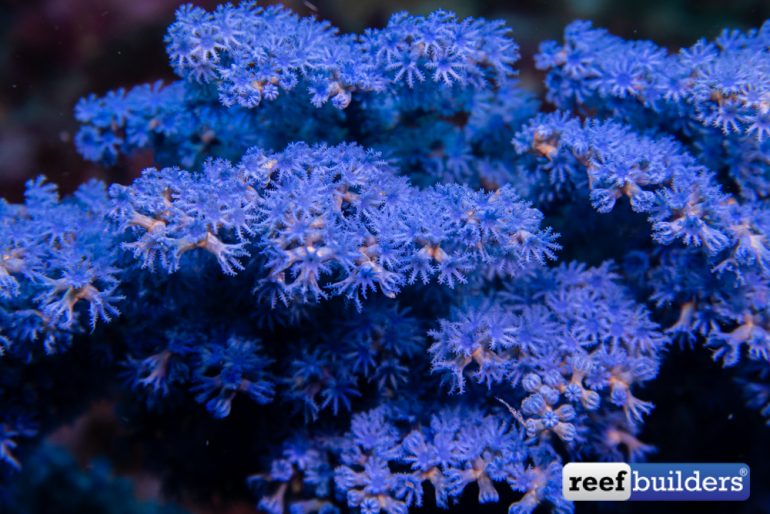Soft Corals, Gorgonians, and Sea Pens comprise the Octocorallia, a major branch in the coral tree of life whose 3000+ species come in nearly every shape imaginable. Not surprisingly, this biodiversity has confounded taxonomists for centuries, resulting in no shortage of competing evolutionary theories. To fully appreciate the confusion surrounding this group, it helps for us to start at the beginning.
When Carl von Linné published his seminal Systema Naturae in the 1700s, he could comfortably fit all of the known corals within a pair of unwieldy taxa— the Lithophyta (“stony plants”) and Zoophyta (“animal plants”)—encompassing just a handful of genera. In the former, we find the Organ Pipe Corals (Tubipora), the Fire Corals (Millepora), and the Stony Corals (Scleractinia), united on account of their hard skeletons, though now recognized as being very distant relatives within Cnidaria, while the latter includes a variety of vaguely plant-like animals, such as the Soft Corals & Gorgonians, along with Hydroids, Bryozoans, Sponges, and even some algae and protists. It was an imprecise system, to put it mildly.
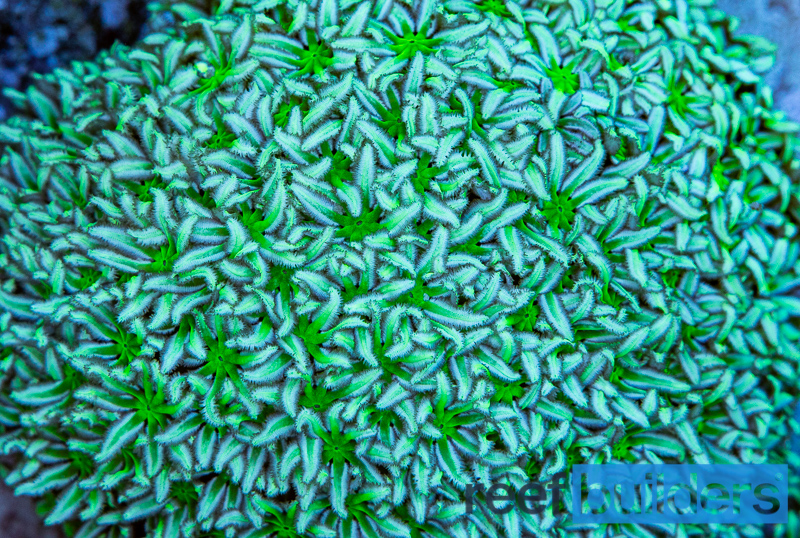
There was little advancement in our understanding until an 1816 publication by the French naturalist Jean Lamouroux, History of flexible coralligenous polyps, commonly called zoophytes. This work formally established the orders Gorgonacea and Alcyonacea, for the Gorgonians and Soft Corals, respectively, though it’s certainly true that earlier authors understood the distinction between these two morphotypes. By 1830, another French naturalist, Henri de Blainville, had iterated on this further, recognizing 4 families of Zoophytes: Tubiporea for the stoloniferous species, Corallia for the Gorgonians, Pennatularia for the Sea Pens, and Alcyonaria for the Soft Corals. The later addition of the Helioporacea for the peculiar Heliopora Blue Corals, which had previously been considered a stony coral (up until it was properly studied in 1876), rounded out the group’s classification for much of the next 200 years, albeit with minor tweaks and name changes along the way.
One major source of contention surrounded a few enigmatic species described as being solitary, rather than colonial (as is the case for all other octocorals). Herein we find such obscurities as Haimeia funebris, a small species described from Algeria in 1857 and unreported since, Monoxenia darwinii, a small species reported from the Red Sea in 1876 and unreported since, Hartea elegans, a small species reported from Dublin in 1856 and unreported since, and Psuchastes glacialis, a small species reported from Edinburgh in 1859 and unreported since. Notice a pattern there? Given the paucity of specimens available for study, it became commonplace to question the veracity of these reports and to presume that these species had been described from colonies that had not yet attained their mature form. On the other hand, several authorities preferred to regard these as a primitive offshoot of octocoral evolution and recognized a new order or “grade”, the Protoalcyonaria. The validity of this group gained new adherents with the discovery in the 1970’s of a large, solitary deepwater species in the Pacific Ocean, Taiaroa tauhou, and the 2018 discovery of a reddish, solitary species from deepwater habitats of the Kuril Islands, Ignis rubeus, proving once and for all that solitary octocorals are indeed a thing that exists.
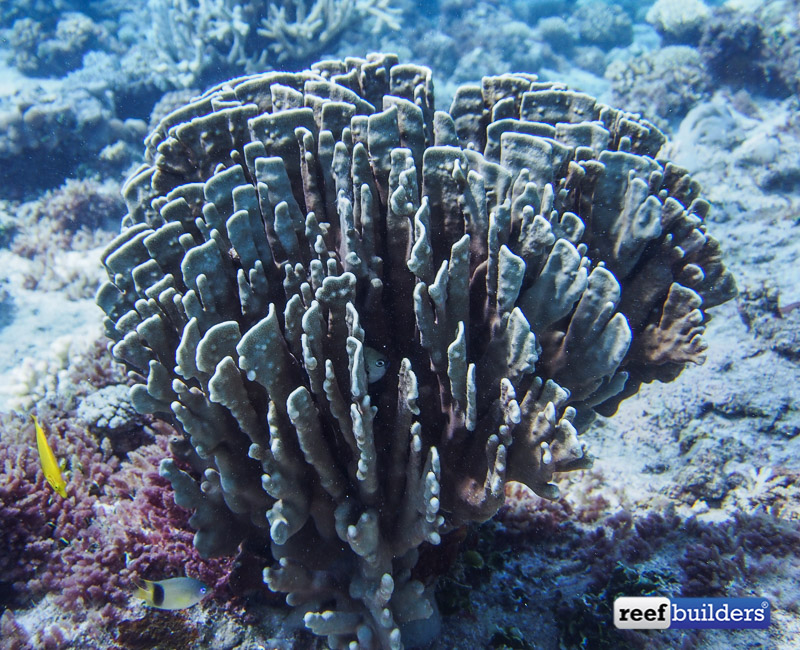
There were also longstanding questions as to how best organize Gorgonian biodiversity, and at this point it is helpful to define exactly what we mean with this term. There is no one-size-fits-all definition for what a Gorgonian entails, but it can generally be applied to those octocorals that develop rigid, vertical colonies, stiffened either by an axial skeleton or a conglomeration of sclerites. This is, however, a very imperfect solution, as there are Soft Corals like Chironephthya that closely approximate a true Gorgonian, while Briareum comes either in encrusting or arborescent species, such that it has often been likened to a sort of proto-Gorgonian.
To classify these, systematists have come up with varying solutions. Théophile Studer’s influential 1887 study settled upon 2 major lineages, the Scleraxonia and Holaxonia, signifying whether the axial skeleton was derived from fused sclerites or some other means, such as flexible proteins or solid calcium. In the former were tropical genera like Briareum, Annella, Subergorgia, and Melithaea, plus the Mediterranean’s famed Precious Coral, Corallium rubrum, and the deepwater Bubblegum Corals, Paragorgia (though this would later be regarded as a Soft Coral). The latter comprised all other Gorgonians, including those with a proteinaceous axial skeleton, those with calcitic or aragonitic axial skeletons, and still other groups that combined both traits, thus producing axial skeletons of alternating proteinaceous and calcitic nodes and internodes, commonly called Bamboo Corals. Naturally, subsequent authors subdivided Holaxonia further, establishing a separate order (or suborder), Calcaxonia, for those groups possessing axial skeletons of solid calcium, most of which are restricted to deepwater habitats, though with a few constituents found on tropical coral reefs.
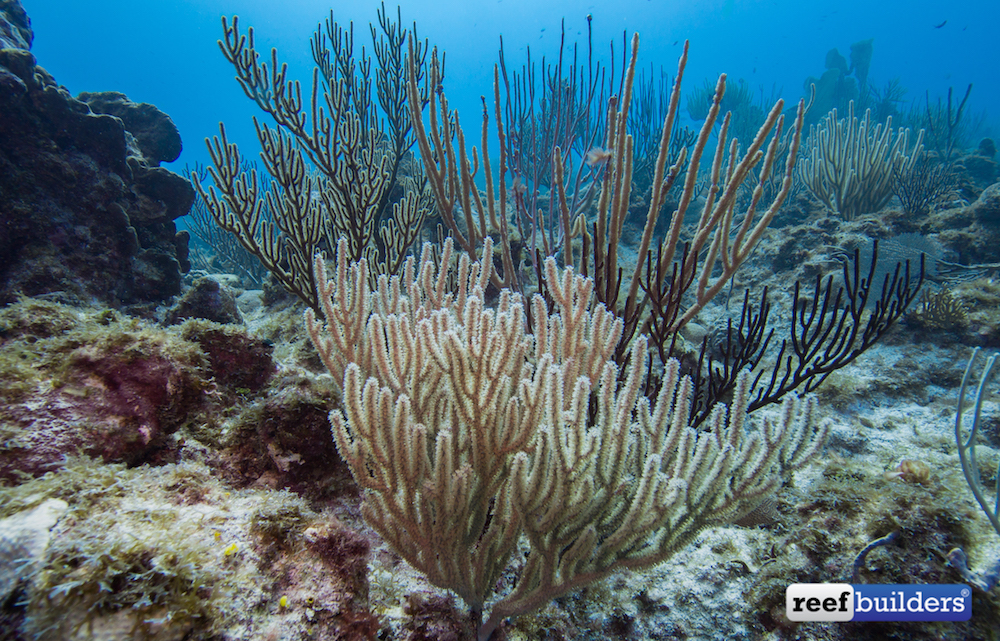
And there are still other nomenclatural permutations that bear mention. A few octocorals are notable for producing rigid colonies that combine stolons and prominent axial polyps, which then often become arborescent by giving rise to sidebranches (in this sense, morphologically analogous to Acropora). This includes tropical genera like Carijoa, Coelogorgia, and Paratelesto, along with poorly understood rarities like Telesto, Telestula and Pseudocladochonus. The axial polyp bears some superficial similarity to the central stalk (“rachis”) of a Sea Pen, such that these seemingly disparate lineages were briefly consolidated together as the Stelechotokea in a paper by Gilbert Bourne in 1900, which was later refuted by Sidney Hickson in 1930, when he instead established a separate order for them, the Telestacea. And yet another small order, the Gastraxonacea, was conjured up for the little-known South Australian Pseudogorgia godeffroyi, whose long axial polyp includes an equally elongated gastric cavity (unlike the short gastric cavities of the telestaceans).
Thus, at its most complex and unsavory, octocoral taxonomists have recognized as many as 8 orders. These roughly follow a system of increasing complexity, from the simple polyps of the Protoalcyonaria to the creeping colonies of the Stolonifera, giving rise to more “advanced” forms like the Telestacea and Gastraxonacea, which in turn leads to the various Gorgonians in Scleraxonia, Holaxonia, and Calcaxonia. And let’s not forget the Alcyonacea and Helioporacea, which fit in there somewhere. Plus the Sea Pens, whose complex colonies are sometimes viewed as the apogee of octocoral evolution.
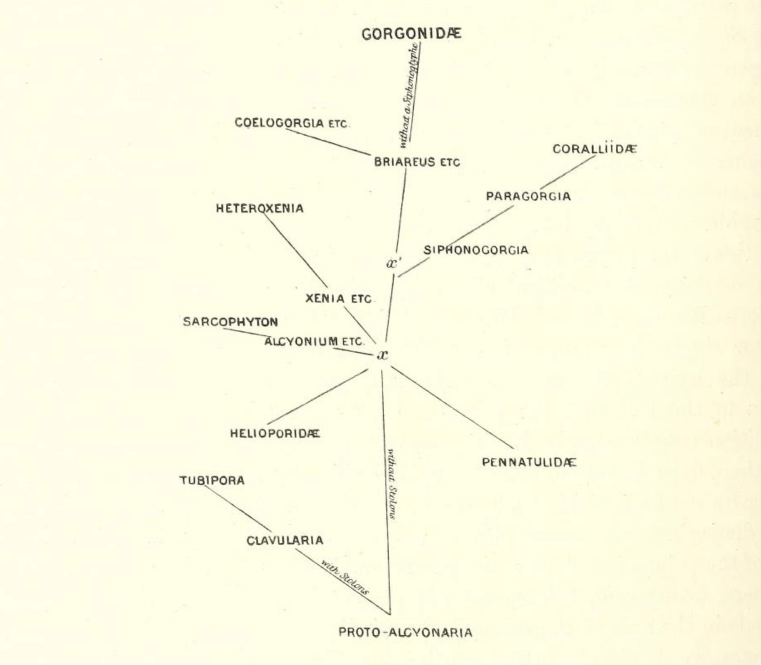
But friends, all of this is a lie. 300 years of nomenclatural malfeasance. This long prelude was to whet your appetite, so that your jaw may properly drop as I reveal what recently occurred in the esoteric field of octocoral systematics. In October 2022, a long-awaited study from octocoral guru Cathy McFadden, the late Leen van Ofwegen, and the Smithsonian’s coral geneticist extraordinaire, Andrea Quattrini, would stand all of these morphological assumptions on their head. Building upon decades of incremental work, painstakingly combining heaps of molecular data and electron microscopy, these authors have at long last revealed a true picture of this group’s evolutionary history, and the scope of their reclassification is simply astounding.
If you’re feeling impatient and enjoy reading through dense taxonomic jargon, you can peruse the study in the link below. Otherwise, stay tuned for future installments in this series…
McFadden, C.S., van Ofwegen, L.P. and Quattrini, A.M., 2022. Revisionary systematics of Octocorallia (Cnidaria: Anthozoa) guided by phylogenomics. Bulletin of the Society of Systematic Biologists, 1(3).
About the author
Joe Rowlett is the author of Indo-Pacific Corals and studies marine biogeography and speciation. He is a former aquarist and has written extensively for aquarium publications.


